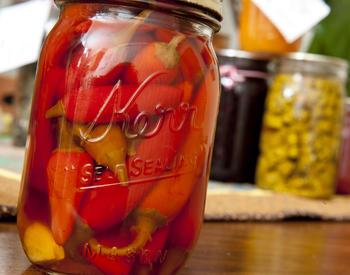Canning Soup (SP 50-931)
Download this publication as a PDF
Vegetable, dried bean or pea, meat, poultry or seafood soup can be canned.
Caution: Do not add noodles or other pasta, rice, flour, cream, milk, or other thickeners to home-canned soups. If dried beans or peas are used, they must be fully rehydrated first.
General procedure
- Select, wash and prepare vegetables, meat and poultry as described for the specific foods.
- Cover meat with water and cook until tender.
- Cool meat and remove bones.
- Cook vegetables.
- For each cup of dried beans or peas, add 3 cups of water.
- Boil 2 minutes, remove for heat, soak 1 hour, and heat to boiling; drain.
- Combine solid ingredients with broth, tomatoes or water to cover. Boil 5 minutes.
- Salt to taste, if desired.
- Fill jars halfway with solid mixture.
- Add remaining liquid, leave 1-inch headspace.
- Adjust lids and process following the recommendations in Table 1 or Table 2 according to the method of canning used.
- After processing, remove canner from heat and wait until pressure returns to zero.
- Remove weight or slowly open petcock.
- Wait 10 minutes.
- Unfasten canner lid and remove carefully.
| Style of pack | Jar size | Process time | Pounds of canner pressure, 0 –2,000 ft altitude | Pounds of canner pressure, 2001–4,000 ft altitude | Pounds of canner pressure, 4001–6,000 ft altitude | Pounds of canner pressure, 6001–8,000 ft altitude |
|---|---|---|---|---|---|---|
| Hot | Pints | 60 minutes1 | 11 lb | 12 lb | 13 lb | 14 lb |
| Hot | Quarts | 75 minutes2 | 11 lb | 12 lb | 13 lb | 14 lb |
| Style of pack | Jar size | Process time | Pounds of canner pressure, 0–1,000 ft altitude | Pounds of canner pressure, above 1,000 ft altitude |
|---|---|---|---|---|
| Hot | Pints | 60 minutes1 | 10 lb | 15 lb |
| Hot | Quarts | 75 minutes2 | 10 lb | 15 lb |
Clam chowder base
Yield: about 20 half-pints or 10 pints
- 1/2 pound diced salt pork (optional)
- 2 quarts diced and peeled potatoes (about 8 medium)
- 1 cup chopped onion (about 1 medium)
- 3 or 4 quarts cleaned, chopped clams with juice
- 2 quarts boiling water
- Salt and pepper
Directions:
- Cook salt pork until light brown in a large saucepot. (Bacon could be added before serving instead of using salt pork).
- Drain off excess fat.
- Add onion and cook until onion is tender but not brown.
- Add clams with juice, potatoes and water.
- Boil 10 minutes.
- Season to taste.
- Process half-pints or pints (not quarts).
- Ladle hot chowder base into hot jars, leaving 1-inch headspace.
- Adjust two-piece caps. Process half-pints and pints 100 minutes in a pressure canner (10 pounds with a weighted gauge; 11 pounds with a dial gauge).
To serve: For New England clam chowder, add 2 tablespoons butter and 2 cups milk to each pint of clam chowder base before heating for serving. Reduce butter and milk by half for each half-pint of clam chowder base.
Do not add butter and milk before canning.
Recipe variation
For Manhattan chowder, add the following ingredients, removing bay leaf before canning.
- 2 cups cooked tomatoes
- 1/2 bay leaf
- 1/2 cup chopped celery (about 1/2 stalk)
- 1/2 teaspoon thyme
Processing meat stock (broth)
After cooking broth, strain and remove most of the meat scraps and fat. Ladle hot broth into hot jars leaving 1-inch headspace, wipe rims and adjust lids. Process in a pressure canner.
NOTE: We do not have recommended processing times for fish or other seafood-based broth or stock. These products freeze well.
| Style of pack | Jar size | Process time | Pounds of canner pressure, 0– 2,000 ft altitude | Pounds of canner pressure, 2001–4,000 ft altitude | Pounds of canner pressure, 4001–6,000 ft altitude | Pounds of canner pressure, 6001–8,000 ft altitude |
|---|---|---|---|---|---|---|
| Hot | Pints | 20 minutes | 11 lb | 12 lb | 13 lb | 14 lb |
| Hot | Quarts | 25 minutes | 11 lb | 12 lb | 13 lb | 14 lb |
| Style of pack | Jar size | Process time | Pounds of canner pressure, 0–1,000 ft altitude | Pounds of canner pressure, above 1,000 ft altitude |
|---|---|---|---|---|
| Hot | Pints | 20 minutes1 | 10 lb | 15 lb |
| Hot | Quarts | 25 minutes2 | 10 lb | 15 lb |
Related Articles
- Preserving Garlic
- Canning Meats, Poultry and Fish: Problems and Solutions
- Preserving Summer Sausage and Deli Style Meats
Source: OSU Master Food Preserver Program
This document was adapted from the "Complete Guide to Home Canning," Agriculture Information Bulletin No. 539, USDA.

 Extension Service
Extension Service